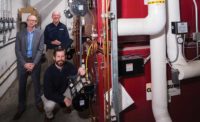When a project at the National Academy of Sciences building in the nation’s capital gets dropped on your desk, you want to impress.
That’s exactly what happened to Todd Garing, vice president with Mueller Associates, when he took the lead for the complete mechanical, electrical and plumbing overhaul of the historic building in Washington, D.C.
“This is the National Academy of Sciences, so we tried to be as energy efficient as practical,” says Garing, who has 20 years of engineering experience and has been with Mueller Associates since 1993. “We tried to introduce energy-saving strategies wherever we could.”
Mueller Associates was awarded the project in February 2008 and put the finishing touches on the job this past April. The National Academy of Sciences building — a 199,000-sq.-ft. facility that is the headquarters and conference center for scientific- and technology-related research — was first constructed in 1924 and is listed on the U.S. National Register of Historic Places. The academy was chartered by Congress in 1863 as a private, nonprofit society of scholars who can provide advice to the U.S. on matters of science and technology.
Washington-based Quinn Evans Architects designed the rehabilitation of the project, which included the preservation of the building’s historic features while adding contemporary amenities. The NAS building was required to meet the DC Green Building Act of 2006 that requires that all District public buildings meet the U.S. Green Building Council’s LEED certification standards for environmental performance.
For Mueller’s part, the project started with the basics. Many of Washington’s historic building revamps require separate plumbing lines for sanitary and storm water.
“The original parts of the building didn’t separate the sanitary and the storm water,” Garing says. “D.C. requires the sanitary water and storm water to exit the building separately. Even though this part of D.C. is still a combined sanitary and storm sewer, when the municipal mains in the street are upgraded and separated in the future the separated building mains will permit connections to the proper systems.
“Now, the building has separate lines. The storm water is filtered on-site to comply with storm-water quality requirements before it connects to the municipal combined sanitary and storm main.”
Piece of the pie
Day-to-day operations at the NAS building are constantly in flux. There are 153 offices that cover more than 64,000 sq. ft.; including support space such as rest rooms, conference rooms and more. Throughout the year, the building hosts many different events from smaller meetings to an annual conference. So, it was critical for the building’s food operations to get a major overhaul during the renovations.
“There is a full-service kitchen,” Garing says of what is now in place. “They have the capability of serving a lot of food to people. When the national academy gets together for its various meetings, there are a ton of people in this building.”
Having a building where there isn’t a consistent use of the kitchen was a challenge for Garing’s design.
“From the mechanical perspective of the plumbing and the HVAC, that can be demanding,” he says. “This food service is a big deal, but sometimes it can just be a basic cafeteria where people are down there for lunch, or they are hosting events with full catering.”
Garing and his team specified a Thermaco grease recovery device in the kitchen and a variable-flow intake air and exhaust system with the range hoods. There are two hoods split in the kitchen with one in the back for heavy cooking and one in the serving area for use on lighter cooking days. Using a variable-flow intake and exhaust system that responds to cooking demand in lieu of a constant volume system saves the building on energy costs.
“It monitors the temperature of the air leaving the hood and if it’s low, that implies there’s not much or no equipment on in the hood area,” Garing says. “It lowers the makeup and exhaust air flow in the kitchen. That’ll save a lot of energy. Splitting the hoods was also beneficial because they may only use the serving area and then the main kitchen hood is off. Rather than having all the kitchen equipment under one giant hood and having it on all the time, it helps reduce the amount of air flow required for makeup and exhaust.”
With all the enhancements the kitchen received, putting all the plumbing pieces together was a challenge for Garing and Mueller.
“From an MEP perspective, essentially everything in the building is brand-new,” Garing says. “We put in a new system for the kitchen. There was a lot of integration required to make this successful; coordination with the existing structure and the location of the equipment. We had to get all the connections worked out and determine which pieces of equipment could go to sanitary and what should go to the grease recovery device.”
Garing and his team of engineers designed the job using Autodesk Revit software, a building information modeling program. He says the use of BIM was integral in making the job run smoother.
“That was very useful to put everything together,” Garing says. “Because space was so tight, everything was modeled — all the piping, the ductwork, the structure. It really helped us coordinate all the pieces of the project.”
Joe Papa, the NAS building director of operations for the last 17 years, is happy to come to work at the NAS building where everything is running much cleaner and the building is much more eco-friendly.
“Replacing the plumbing so there are no leaks has been a key,” he says. “We installed a dishwasher and we never had that before. The whole place was on plastic plates and cups. Now, we’re on china.”
Getting steamy
The NAS building primarily gets its heating hot water from the three steam-to-hot water converters. The Armstrong converters have a total capacity of 8,500 MBH. New piping had to be installed because of the run-down condition of the original piping.
“The General Service Administration is the primary source of heating. There are steam-to-hot water converters that provide hot water to the hydronic steam to heat the building,” Garing says. “Also, there are Armstrong instantaneous steam-fired water heaters which provide the domestic hot water to the rest of the building.”
Oventrop solar thermal collectors were installed on top of the building to help ease the usage of the steam convertors. Garing estimates the solar thermal collectors are handling the lion’s share of the hot water load.
“We have water heaters dedicated to the kitchen and then we have a water heating system for the rest of the building,” he says. “This system is supplemented by a solar thermal collector which is mounted on the roof and takes the sunlight, converts it into energy and preheats the water before it gets to the steam converter. There are times when the steam heat exchanger doesn’t have to run at all. On the days when there aren’t huge meetings, the domestic water isn’t needed as much and the solar collector can handle the demand.”
Trending gold
The NAS building has applied for the U.S. Green Building Council’s LEED Gold certification based on the project’s use of daylight harvesting, solar thermal domestic water heating, low-flow plumbing fixtures and other elements. According to an AIA report, energy has been reduced by 26.7% since last year with the introduction of the energy-efficient mechanical systems with digital controls, upgrades to the windows and LED and florescent lighting with digital controls.
Garing states the solar collectors with building-integrated photovoltaic panels will result in about $3,000 in energy savings per year. “The BIPVs were viewed as an important demonstration tool rather than trying to obtain enough on-site generation for a LEED credit,” he says. “These help shade the skylights and make the glass perform better because it doesn’t let as much light go through. And the light that is hitting the glass is being turned into electricity.”
All bathrooms utilize low-flow fixtures with 1-pint urinals and 1.28-gpf toilets from American Standard, Sloan, Kohler, Speakman and Elkay among others. The faucets are on electronic sensors and dole out water at 0.5 gpm. Using these products is standard operating procedure for Mueller Associates.
“All those products are proven,” Garing says. “We haven’t experienced problems. The biggest challenge is the pressure requirements are quite high.”
The NAS building addressed the pressure issue by installing a domestic water pressure booster. The Tigerflow booster includes products from Grundfos and Watts Water and helps the building, which doesn’t get strong water pressure from the municipal main.
“We put in variable-frequency controlled pumps so they could be modulated and staged on and off,” Garing says. “Rather than set it to a pressure right at the discharge point, we called for the first pressure sensor to be at the first takeoff point. This allows the system to reduce pressure requirements during periods of low demand.”
On a busy day at the NAS building, such as when the lawn is being irrigated while a large meeting is taking place, the pressure booster is critical to maintain normal functions.
“When it’s a peak day and there is a lot going on in the building, the pressure drop from the domestic water main can be significant,” Garing says. “Most of the days the pressure drop is minor. It did not make sense to set the pressure back at the pump for the high pressure needed to overcome that piping loss 365 days a year. It is better to only provide the additional pressure when it’s needed. We did that by locating the sensor downstream where the pressure is critical.”
Papa says the controls he has at his disposal have been a nice addition, especially how he can set the building at a certain temperature and not have to worry about one area not receiving cool air in the summer or warm in the winter.
“Prior to the renovations, things were either on or they were off,” he says. “Before we didn’t have adequate air conditioning. Now, we have air conditioning set right on the dollar. We set our temperature right at 78° F and every room is 78°.”
The project has won two awards: an AIA Northern Virginia Award of Excellence and a DC Historic Preservation Award.
“We take great pride in the successful completion of this project,” Garing says. “NAS now has energy-efficient mechanical systems that respond to the varied demands of the building and will serve them well for many years.”







